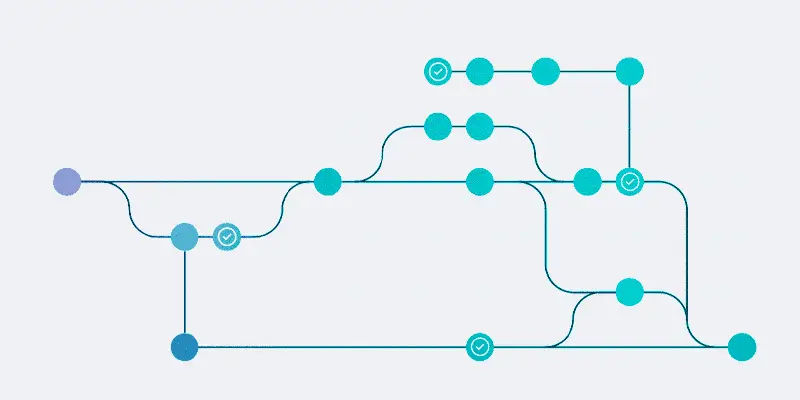Keeping track of changes to your main code repository throughout the Salesforce DevOps pipeline can become challenging. There are many sources for these changes, and these changes can occur at a variety of times. So how do you maintain control of the code changes while ensuring errors don’t arise?
Salesforce source control is the practice of managing the changes to the code throughout the DevOps pipeline.
Salesforce version control is a useful tool aimed at accomplishing this goal. In fact, source control and version control are so closely linked that the terms are often used interchangeably.
Version control is the cornerstone of a developmental organization and a critical component of a complete DevOps strategy. It’s a way of managing software revisions or updates over time with time stamps and personal markers. These changes can then be compared, restored, and merged.
Source control methods are an essential aspect of producing reliable software updates and applications in a streamlined manner. But what exact benefits can be seen from utilizing Salesforce version control?

Here are 7 ways source control helps Salesforce developers:
1. Supports Team Based Development
It’s no secret that tasks can be more quickly accomplished when multiple people are working toward a shared goal. However, it can be difficult to properly manage, oversee, and facilitate the efforts of a large team. This is especially true when team members are spread throughout multiple geographic areas, which is becoming more and more prevalent.
Salesforce version control is a great way to merge the efforts of multiple developers while ensuring their efforts are properly directed.
The ability to maintain accountability in a team-based setting allows management to ensure everyone’s contributions are made according to company standards and policies. Recognizing a certain team member making consistent mistakes is a great learning opportunity. This wouldn’t be as easy to rectify if management didn’t know who was making the mistake.
2. No More Overwrites
A frequent result of team-based development projects is code overwrites. This occurs when two team members accidentally address the same aspect of a DevOps project. Working directly within the main code repository doesn’t allow you to rollback your changes when an error is found.
Salesforce version control allows each team member to work in their own environment so that any errors don’t directly impact the entire project.
Allowing various developers to work on their own branches of the project enables testing before merging with the main repository. This helps identify any areas that could potentially interfere with other updates to the code. It also provides insight into code overwrites so nothing goes unnoticed.

3. Reduction of Merge Conflicts
Merge conflicts are the result of two developers that have both addressed the same lines of code in a project. We’ve discussed the importance of avoiding overwrites, and these conflicts go along the same lines.
Conflicting code can negatively impact the functionality of updates and lead to a broken deployment.
Independent branches for your developers mean you can rollback your updates at any time. This is a great way to avoid the negative effects of a merge conflict. Once you notice an error, simply revert to an older version of the project and address the issues like the merge never happened.
4. Provides Clear File Structure
Properly managing a DevOps project involves clear directions so there is no confusion among team members. Salesforce version control offers many ways to not only operate within a structure, but also to put the structure itself together.
Salesforce version control organizes DevOps projects into a clear structure to enable better communication, reduce confusion, and minimize errors.
This type of organizing enables effective merging of everyone’s code into the main code repository. It updates the team on their progress, and tracks issues and bugs when they are integrated with application lifecycle management platforms.
5. Regular Backups of Code
Mistakes are going to happen. Code can become damaged or otherwise compromised through team errors, or even natural disasters. Maintaining a current backup of all the changes to the code repository provides an essential fail-safe for all such scenarios.
Backups of the various branches and the main code repository are made by the version control tool, so your team doesn’t have to perform redundant tasks after a data loss event.
A reliable backup can save your team a lot of time and money. Version control creates automatic backups throughout the development process, so you don’t have to worry about what happens to the lines of code when the worst-case scenario occurs.

6. Successful Deployments
All of these benefits work toward creating a more secure, stable, and reliable DevOps project. Your application or update will have stronger lines of code and dependable functionality, contributing to a successful deployment.
Failed deployments come as a result of the existence of bugs, improper coding structure, or other issues with the general framework of the update.
Version control’s many checkpoints and quality assurances contribute to an eventually successful deployment. Combining these efforts with other DevOps tools such as CI/CD and static code analysis further guarantee an effective deployment and profitable pipeline.
7. Works in a Variety of Architectures
There are a variety of options for your DevOps systems. Three of the most popular options are Git, SVN, and Azure DevOps. Luckily, the AutoRABIT platform supports all three of these options for version control.
Git
- Server Architecture: Installed locally and acts as both server and client.
- Branching: Branches are references to a certain commit. They can be created, deleted, and changed at any time without affecting other commits.
- Change Tracking: Repository level
SVN
- Server Architecture: Requires a centralized server and user client.
- Branching: Branches are created as directories inside a repository and when the branch is ready, it is committed back to the trunk.
- Change Tracking: Repository level
Azure DevOps
Change Tracking: Repository level
Server Architecture: Centralized
Branching: No concept of local branches or local check-ins. Local workspaces are always connected to the central repository.
